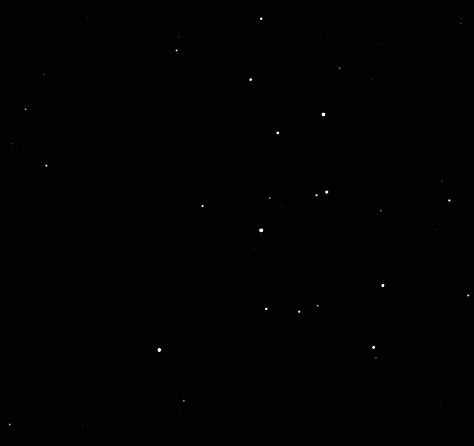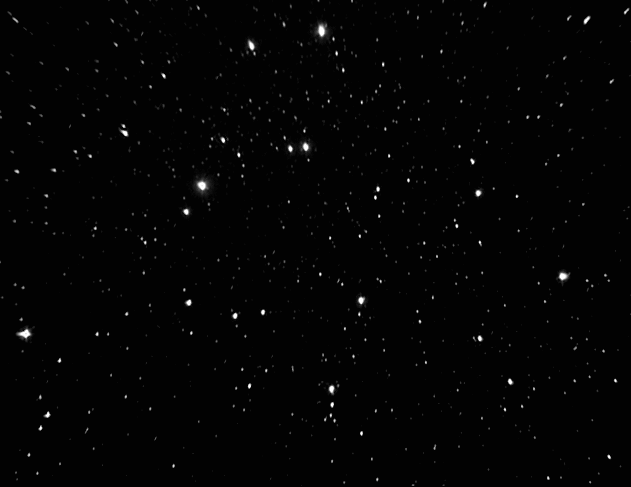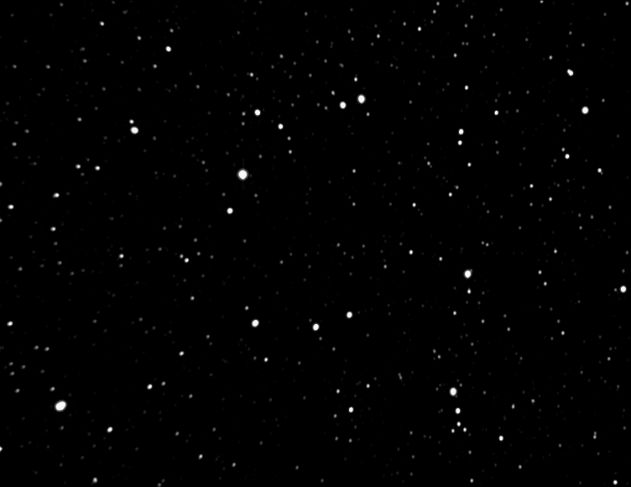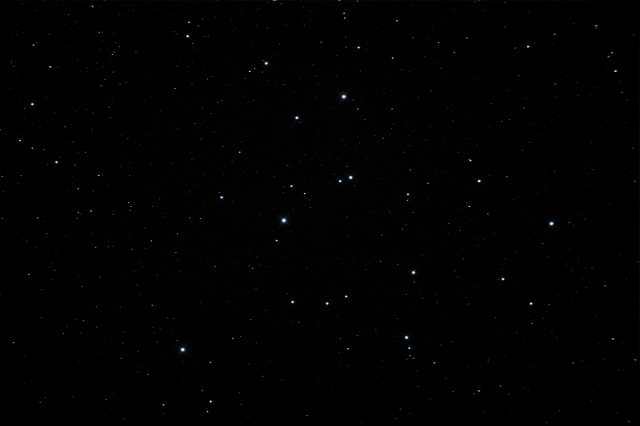

There is some doubt about the discovery of M39. It may just be visible to the naked eye and as such may have been known since antiquity, and there is a suggestion that Aristotle remarked on it in 325 BC. It may have been noted by Le Gentil in 1750, but the evidence is poor. What is known is that Charles Messier included it in his catalogue on 24th October 1764. It is 800 light years away and is thought to be 200-300 million years old. There are 30 stars within a diameter of 7 light years proved to be members of the cluster.
 |
M39 captured with my DMK camera fitted with a 270-mm SLR lens at f/5.6. The diameter of the cluster is about 32 minutes of arc. The cluster as a whole is said to have a magnitude of about 5, which would make it visible to the naked eye, but it's brightest star is only magnitude 6.6 which is below naked-eye visibility for most people even under very dark skies. Date and Time: 3rd July 2010 22.30 UT Camera: DMK 21AF04 Telescope: 270-mm SLR lens Capture: ICCapture. Exposure 55.3 seconds. Processing: K3CCDTools. 15 frames stacked, unsharp mask 3,0,100 PhotoImpact. Contrast 10 |
||
 |
And here a much deaper picture. This was taken with my ETX125 fitted with a Meade 0.33 focal reducer and my MX716 camera. Date and Time: 1st November 2010 19.07 UT Camera: Starlight Xpress MX 716 Telescope: ETX125 fitted with 0.33 focal reducer Capture: Star_mx7. Exposure 20 seconds, 10 frames. Processing: Star_mx7. Black level, enhancement factor 25, black level RegiStax5. 10 frames stacked, gamma 1.5, histogram 18-255 PhotoImpact. Shrunk to 85%, vertical flip, Focus Magic 3, 100 |
||
 |
And here with my LX200. This is somewhat too large a format for this object. The image is about 26×20 arc-minutes and the cluster is given as 32 arc-minutes across. Date and Time: 7th October 2011 20.55 to 20:57 UT Camera: Starlight Xpress MX 716 Telescope: LX200 fitted with 0.33 focal reducer and CLS filter. Capture: Star_mx7. Exposure 10 seconds, 10 frames. Processing: Star_mx7. Black level, enhancement factor 25, black level. RegiStax6. 5 alignment points, 10 frames stacked, Gaussian wavelets Scheme 3, Dering dark side 190. PhotoImpact. Shrunk to 85%, vertical flip, Focus Magic 1, 100. |
||
 |
This picture was taken with my RC and a DSLR (Canon 1100D). The primary purpose was to see if this combination produced significant vignetting. It did but it was very slight and easily compensated by a flat frame. The full-scale image also reveals slight coma indicating a slight misalignment of the mirrors. However the aberation is not visible when reduced to fit the computer screen. For depth I could have used longer exposures, but I was not using guiding and only one of the five frames I took at 80 seconds did not show drift, and the background shine was too great as well. Date and Time: 18th November 2019 20.09 to 20:17 UT Camera: Canon 1100D Telescope: 8-inch Ritchey-Chrétien reflector. Capture: Exposure 5 frames each of 10, 20, 40, and 1 at 80 seconds, 16 frames. Processing: RegiStax5. 16 frames stacked, wavelets 1-2=10, gamma 1.4. PhotoImpact. Shrunk to 15% to fit the screen |
||
Home Back to DSOs